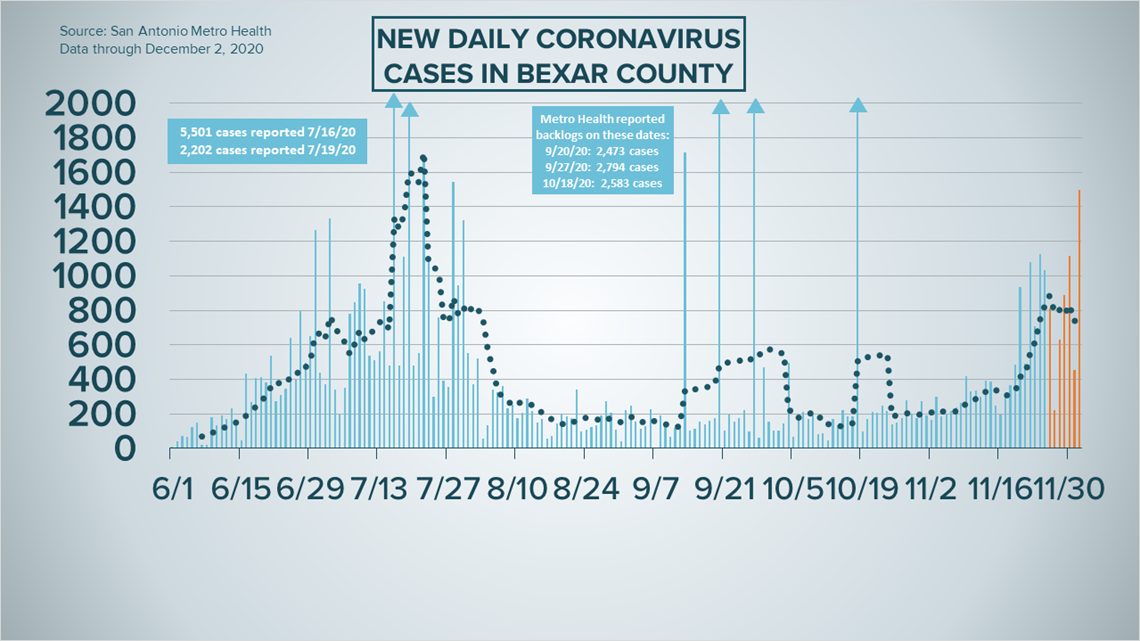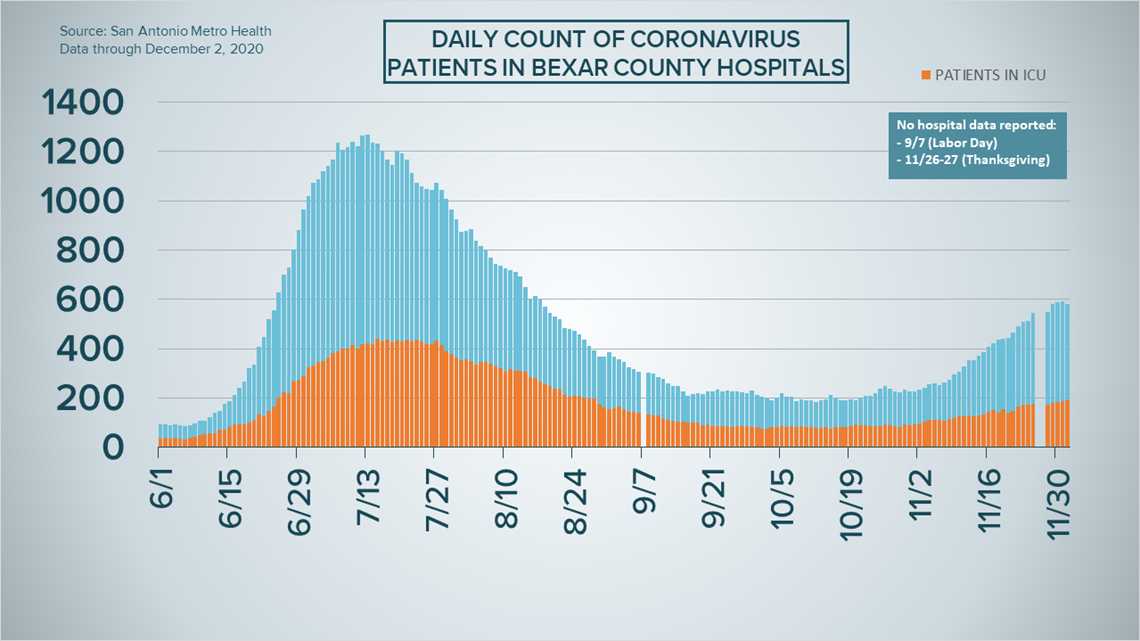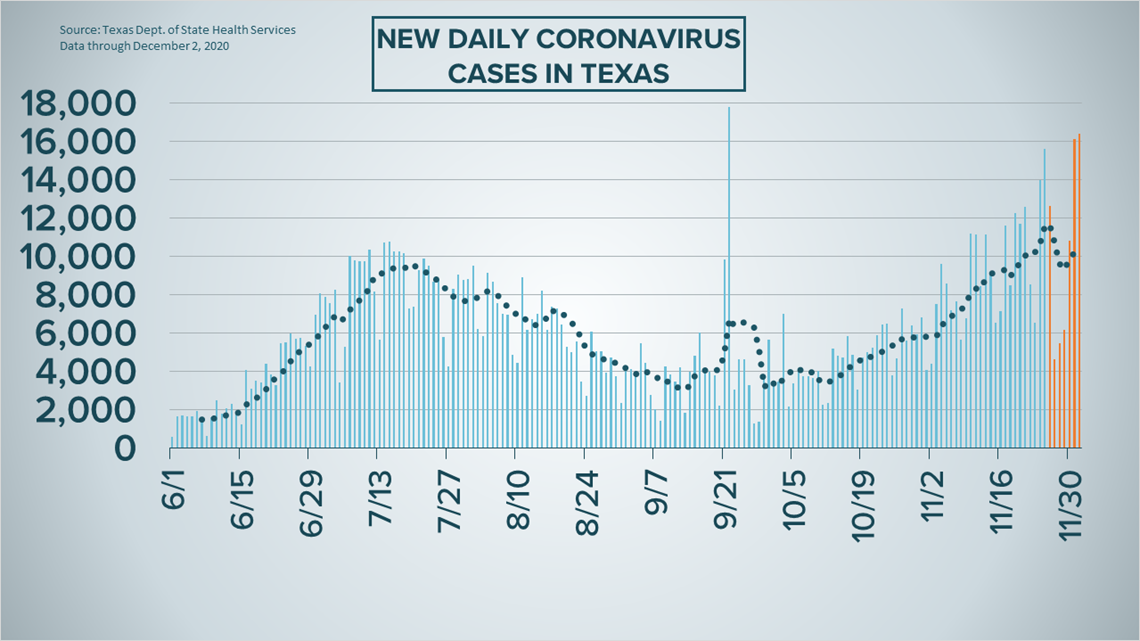SAN ANTONIO — We're tracking the latest numbers from the coronavirus pandemic in San Antonio and across Texas. Here are the latest numbers reported by Bexar and surrounding counties:
- Bexar County: 1,499 new cases were reported on Wednesday, bringing the total number of cases to 83,125. Nine new deaths were also reported, raising the death toll to 1,371.
- Hays County: Officials in Hays County on Wednesday reported 97 new cases in the county and no additional COVID-related fatalities. As of Wednesday, there are a total of 7,526 lab-confirmed local cases (738 of which are active), while the death toll stands at 104. 6,684 residents have recovered from the virus.
- Comal County: Comal County reported an additional 93 coronavirus cases – 67 are confirmed, 25 are probable, and one is a suspect case – on Thursday bringing its total to 4,786. One new death from COVID-19 complications was reported by local officials, so the local death toll is now at 131. The county estimates 470 active cases on Thursday.
More county case information is available through the Texas Department of Health Services COVID-19 dashboard.
How Bexar County is trending
We've tracked how many coronavirus cases have been confirmed in Bexar County from the time officials began reporting cases in March 2020. The graphic below shows the number of cases since June and charts those daily case numbers along a 7-day moving average to provide a more accurate picture of the overall coronavirus case curve in our area and the direction we're trending amid the pandemic.
On Wednesday evening, San Antonio Mayor Ron Nirenberg reported an additional 1,499 novel coronavirus cases in Bexar County—more than three times the tally reported on Tuesday. A total of 83,125 county residents have been diagnosed with the virus.
Nirenberg also reported nine new coronavirus-related deaths, raising the local death toll to 1,371.


Wednesday brought a minor drop in the number of local hospitalized COVID-19 patients. Health authorities reported 580 hospitalizations, which is 13 fewer than Tuesday. Of those, 103 are on ventilators while 192 patients are in intensive care.


Despite the relatively large case total reported on Wednesday, Nirenberg said that local positivity rates at testing centers are still much lower than numbers observed over the summer. In addition, the city is seeing more residents show up to get tested, which is in turn helping Metro Health track the coronavirus's spread through San Antonio.
Coronavirus in Texas
The total number of novel coronavirus cases in the state since the pandemic began grew by 19,049 on Wednesday, according to the Texas Department of State Health Services.
That total includes 14,758 new confirmed cases and 1,666 cases attributed to backlogs not previously reported in the state's total (more details can be found at the top of this page).
As of Wednesday, nearly 1.26 million Texans have been diagnosed with COVID-19. Of those, 1.2 million diagnoses are confirmed via molecular testing, while another 56,878 are positive antigen tests.


State health authorities also reported 207 additional virus-related deaths on Wednesday, an increase from Monday's reported total of 170. At least 21,756 Texans have died from COVID-19 complications.
The number of COVID-19-related hospital patients, meanwhile, rose by 62 patients over the past 24 hours, and the overall figure is now at 9,109—the highest hospitalization numbers have been for the Lone Star State since the end of July. Hospitalizations continue to trend upward after numbers were flat for most of August and September.
Meanwhile, the state estimates that 993,151 Texans have recovered, while 188,917 Texans remain ill with COVID-19.
The latest update from the Texas Education Agency showed that there have been 50,420 cumulative cases among staff and students across the state through Nov. 15. More information can be found here.
The TEA typically releases new data on school cases every Thursday but not did do so on the Thanksgiving holiday. Officials said the latest numbers will be reported later this week.
Latest Coronavirus Headlines
- Small Businesses need support this year more than ever
- Coronavirus is ablaze in West Texas as tourists flock to Big Bend and Marfa. Hospitals are running out of overflow options.
- COVID-19 risk at 'historic high,' White House task force warns states
- CDC shortens quarantine guideline to 10 days; 7 days with negative test
- 'Precarious risk' for COVID-19 infections over next 30 days, Fauci says
- UK authorizes Pfizer coronavirus vaccine for emergency use
- 'The holiday bubble' | Doctors describe how to plan a COVID-19-safe Christmas gathering
- Panel recommends health care workers, long-term care residents get COVID-19 vaccine first
- Texas Medical Association COVID-19 experts urge testing in schools
- Texas must boost coronavirus control efforts amid "full resurgence" of infections, White House report says
Coronavirus symptoms
The symptoms of coronavirus can be similar to the flu or a bad cold. Symptoms include fever or chills, cough, shortness of breath or difficulty breathing, fatigue, muscle or body aches, headache, new loss of taste or smell sore throat, congestion or runny nose, nausea or vomiting and diarrhea, according to the Centers for Disease Control.
Most healthy people will have mild symptoms. A study of more than 72,000 patients by the Centers for Disease Control in China showed 80 percent of the cases there were mild.
But infections can cause pneumonia, severe acute respiratory syndrome, kidney failure, and even death, according to the World Health Organization. Older people with underlying health conditions are most at risk.
But infections can cause pneumonia, severe acute respiratory syndrome, kidney failure, and even death, according to the World Health Organization. Older people with underlying health conditions are most at risk.
Experts determined there was consistent evidence these conditions increase a person's risk, regardless of age:
- Chronic kidney disease
- COPD (chronic obstructive pulmonary disease)
- Obesity (BMI of 30 or higher)
- Immunocompromised state (weakened immune system) from solid organ transplant
- Serious heart conditions, such as heart failure, coronary artery disease, or cardiomyopathies
- Sickle cell disease
- Type 2 diabetes
The CDC believes symptoms may appear anywhere from two to 14 days after being exposed.
Human coronaviruses are usually spread...
- Between people who are in close contact with one another (within about 6 feet).
- Through respiratory droplets produced when an infected person coughs, sneezes or talks. These droplets can land in the mouths or noses of people who are nearby or possibly be inhaled into the lungs.
- Some recent studies have suggested that COVID-19 may be spread by people who are not showing symptoms.
Help stop the spread of coronavirus
- Stay home when you are sick.
- Eat and sleep separately from your family members
- Use different utensils and dishes
- Cover your cough or sneeze with your arm, not your hand.
- If you use a tissue, throw it in the trash.

